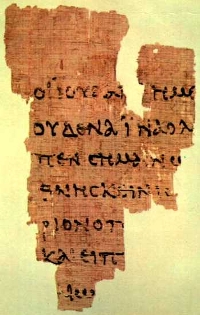It’s been a day, and some more details have become clear about the killing of Osama bin Laden. I thought I’d add a few more thoughts—some of which I didn’t have time to blog yesterday and some of which are in response to what various commenters have posted.
First, was bin Laden chronically stupid or what?
You are the most wanted man in the world, with the world’s most powerful nation on your tail. Okay, so maybe living in a cave isn’t so fun, especially if you have health conditions like Osama was reported to have. And then there are all those pesky predator drones trying to shoot at you out in the hills, so getting under some kind of permanent cover in a more populated area makes sense, but—come on!—the Abbottabad compound? That place positively screams “This is bin Laden’s hiding place!”
It’s built on a hill (strategic defense position), when originally built in 2005 it wasn’t closely surrounded (i.e., was on the edge of town), it’s eight times larger than other local properties, it’s worth a million dollars (in a third-world country where dollars go a looooong way), it has concrete walls 10-18 feet high, the walls are topped with barbed wire, there are two security gates, a seven foot privacy wall around the third floor of the main building, no windows face the road, there are other aerially visible security features and—unlike a mansion built by any other hyper-security conscious rich person in the world—it has no Internet or even telephone service.
Lots of defenses but no way to call for help? Huh? What kind of paranoid millionaire builds himself a pad like that?
Oh, and the locals report the women who live there speak Arabic, and the inhabitants go out of their way to behave weird by never interacting with anybody and by burning all of their trash instead of using the local garbage collection service. And it’s legal owner has no obvious financial means that would allow him to build such an estate.
According to MSNBC,
This home, U.S. intelligence analysts concluded, was “custom built to hide someone of significance.”
That’s kind of appallingly obvious, isn’t it!
Bin Laden’s efforts to remain concealed remind one of the Monty Python sketch, “How Not To Be Seen,” (which is somewhat rude, so be warned).
Yes, having a big macho superfortress with no phone or Internet service will make you a little hard to get at. It probably also strokes your master terrorist-sized ego to strut around in such a place. But it will also make it totally obvious where you are.
It makes it so obvious, in fact, that I wonder why we didn’t identify this place a long time ago—anytime between when it was build in 2005 and now.
I know, I know. It’s easy to connect dots in hindsight. Also, Pakistan isn’t a developed nation and doesn’t have information that’s as easily accessible as here. Further, it’s an uncooperative nation that—while it sometimes helps us, also sometimes deliberately frustrates our anti-terrorism efforts.
I would have thought that our intelligence services would periodically go over our presumably micro-detailed satellite maps of Pakistan and Afghanistan looking for signs of fortresses and then doing a process of elimination.
Such a process of elimination, in this case, might have involved sending in a small, insect-sized robotic probe (like this one, only better [I assume our intelligence services have better ones]) in the dead of night with a button-sized camera (like cell phones have) or a grain-of-rice-sized microphone to see who’s in there—or at least to plant surveillance devices.
For that matter, why not simply, in the dead of night, just lob into the compound a surveillance device disguised as a rock or something and wait to see what it picks up?
But, maybe our technology isn’t quite that good yet (which I find a little hard to believe), or could be too easily detected by anti-bugging equipment bin Laden might have on site, or otherwise might cause him to scamper before we had all our pieces in place.
Or maybe we just gave him too much credit and assumed he wouldn’t do something as stupid as hole up in a monster obvious superfortress but rather choose to stay in a more low-key and harder-to-detect safehouse.
In any event, our guys did finally spot him. He’s dead now, and thus kudos to all of them! I don’t want to be unfair. Hindsight is golden, and all’s well that ends well. Especially terrorist masterminds who get ended. Much obliged, folks! My hat’s off to you! Best of luck with all the nifty new intel you got raiding the superfortress computers and other materials! I hope it all lets you bust up the network good!
The fact that Osama bin Laden was hiding out so close to the Pakistani capital (30 miles as the crow flies; 80 by road), in an upscale, heavily military town which also houses a military academy that is the Pak equivalent of West Point, raises uncomfortable questions about just what the Paks knew about his location.
Monday night I heard an interview with the Pakistani ambassador to the U.S. in which he insisted that they knew nothing of this and that it was just an intelligence blunder not unlike those the U.S. has experienced.
Maybe.
Color me profoundly skeptical.
Given the Pakistani intelligence services’ ties to the Taliban, I strongly suspect that at least some individuals knew where bin Laden was.
Frankly, that’s of secondary consideration at this point. What our leaders need to do is use the obvious discomfort this creates for the Pakistani government to pressure them into helping us find Osama bin Laden’s #2, Ayman al-Zawahiri, and other key al-Qa’eda operatives.
We can let them have their face-saving, “We are your staunch allies against terrorism” bit as long as they get their posteriors in gear and help us root out the remaining terrorist leaders and camps as a show of their “good faith” in the wake of this monumental embarrassment.
If they don’t, and if we get solid evidence that responsible elements in their government did know about bin Laden’s whereabouts then our leaders should deal with them most harshly.
To put it bluntly: Knowingly sheltering Osama bin Laden and his lieutenants from the U.S. is an act of war. It was an act of war for the Taliban back in 2001 (that’s why we went in there, remember?), and it’s an act of war now.
If there are any legal niceties that need to be covered on that score then the appropriate parties in our government should quote Darth Sidious and simply declare, “I will make it so.”
So much for a secular analysis of the situation. Now let’s look at things from a theological perspective.
It has emerged in the last 24 hours that the Navy SEALS (you go, guys!) who were sent on this mission (Operation Geronimo) were instructed that it was a capture-or-kill operation and that bin Laden was given the chance to surrender, which he chose not to avail himself of. It also is reported that the government didn’t seriously expect him to surrender.
The fact that the possibility of surrender was offered to him enhances the moral justifiability of the action, but it was not strictly necessary. If it had been determined that bin Laden must be executed for national security reasons given his involvement in the mass murder of civilians then this would be a defensible application of the death penalty. The precise legal form that such a determination might take (e.g., trial in absentia) could be debated—as could the conclusion of the determination. The point is simply that a surrender offer was not an absolute moral necessity. The fact that they gave it, though, lends additional moral credence to the action.
It is also being reported that the woman who was used or who served as a human shield during the operation may have been one of Osama bin Laden’s wives (he is reported to have at least four, in keeping with what Muslim law permits). If so then he died after trying to hide behind one of his wives.
If that’s so then the U.S. should seriously consider releasing footage of the event (which we apparently possess, or at least may possess) as a way of illustrating to the jihadi world what a wimp and a failure this man was in the end.
(Incidentally, according to reports the government is also looking to release images of the corpse. Those will be gross, but releasing them is probably a good idea since images—even in an age of Photoshop—carry a visceral weight that reports of DNA verification don’t. Bloody photographs would also serve to underscore the humiliating fate that awaits those who attack innocent civilians.)
Now to what strikes me as the central conundrum that many have been puzzling over in the Catholic blogosphere: How to square the impulse to see bin Laden’s body molderin’ in the grave with the impulse to forgive and pray for his soul.
In countless comboxes across the Catholic Internet, people have given voice to both impulses, some openly rejoicing in bin Laden’s death, others expressing regret, and many expressing both sentiments but unsure of how to square them.
Some have pointed to passages in the Old Testament that speak of God as a warrior, a mighty man who slays the enemies of Israel. They have pointed to passages, such as in Esther, where the Jewish people celebrate the destruction of Haman, the enemy of their people. And there are other passages that one could cite as well.
Others have pointed to Old Testament passages that tell us not to rejoice at the fall of our enemies or that God does not rejoice in the death of the wicked but rather wills their repentance. And then there are the “love your enemies” and similar passages in the New Testament.
Many have said they’ve been uncertain how to react—whether to join the celebration at the death of this black hearted villain or feel . . . something else, something less celebratory.
The reality is that all of these perspectives share elements of truth.
Without going into the details of particular passages (at least in this post), several general remarks can be made:
1) We shouldn’t be too quick to embrace the more martial, seemingly bloodthirsty passages of the Old Testament. The Christian faith holds that God led his people, over time, into a progressively more pure understanding of his will. We already see the seeds of universal love displayed in Jesus Christ in the Old Testament, and it comes into full bloom in the New Testament.
2) Neither should we dismiss the Old Testament passages as simply irrelevant. As St. Paul tells us, the Old Testament was written for our example. And while it may represent an earlier phase of God’s revelation to his people that does not fully express all the dimensions of his will, there is truth to be found in even its darkest passages.
3) An important key to understanding the relationship between the two is recognizing that many Old Testament passages speak to the question of justice (or nature), while many in the New Testament speak to mercy (or grace). Both are important aspects of God’s will. Thus we can recognize that it is preferable for the wicked to repent but that if they do not then it is also God’s will that they suffer the consequences of their actions.
4) Even when the wicked have repented, and even when we forgive them for what they have done, this does not mean that there are no consequences from past actions. Our own repentance does not simply obliterate any consequences of our prior misdeeds. Internally—from motives of penance—and externally—from motives of justice for the community—a sinner may still experience punishment and other negative consequences. Thus even a repentant Osama bin Laden would not simply be let off scott free.
5) Based on the way God designed human nature, it is natural to experience positive emotion when the news is received that justice has been done and that safety has been enhanced. It is thus natural to welcome—on an emotional level—the news that Osama bin Laden has paid the ultimate temporal price for his crimes and that he personally can no longer harm us.
6) The love that we are to show to our enemies is not principally a movement of the emotions but an act of the will: An intention to do what we can—even if it is only to wish or to pray—for him and the fate of his soul.
7) The ultimate, objective assessment of the situation is something that only God can make. It likely involves all of the elements previously named: We may rejoice in the things that we may legitimately rejoice in, and we must will the good to our enemies that the Christian ethic requires of us. This means willing the salvation of all if they repent, and it means willing that they repent, but it does not mean willing their salvation in spite of their failure to repent. In the last case, it means willing that they experience what they have chosen for themselves, and what God respects their choice to be as being an eternal rejection of him.
8) Because the foregoing is too complex for us to embrace at any single moment, the human mind in its present state naturally attends to different aspects of it at different moments. At some points we are pulled more toward rejoicing over the things we should rejoice over (e.g., based on justice and nature). At other moments we are pulled toward the things we should will (e.g., based on mercy and grace). This is not unexpected. It is to be foreseen. God does not expect us to hold the whole, complex reality of the situation in our minds at once—either in our feelings or our wills—and so it is perfectly acceptable to alternate between these.
This is why the book of Ecclesiastes states:
There is a time for everything,
and a season for every activity under the heavens: . . .
a time to kill and a time to heal,
a time to tear down and a time to build,
a time to love and a time to hate,
a time for war and a time for peace.
In other words, one can in one moment say, “Yahoo! Osama bin Laden is dead!” and in the next moment say, “Lord, have mercy on his soul!”
What do you think?







